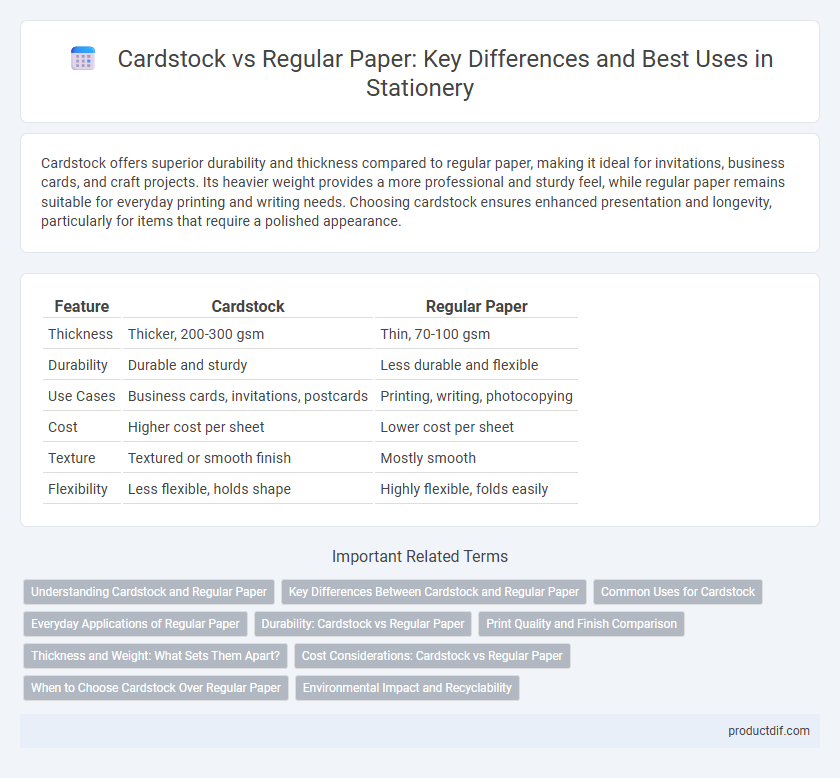Cardstock offers superior durability and thickness compared to regular paper, making it ideal for invitations, business cards, and craft projects. Its heavier weight provides a more professional and sturdy feel, while regular paper remains suitable for everyday printing and writing needs. Choosing cardstock ensures enhanced presentation and longevity, particularly for items that require a polished appearance.
Table of Comparison
| Feature | Cardstock | Regular Paper |
|---|---|---|
| Thickness | Thicker, 200-300 gsm | Thin, 70-100 gsm |
| Durability | Durable and sturdy | Less durable and flexible |
| Use Cases | Business cards, invitations, postcards | Printing, writing, photocopying |
| Cost | Higher cost per sheet | Lower cost per sheet |
| Texture | Textured or smooth finish | Mostly smooth |
| Flexibility | Less flexible, holds shape | Highly flexible, folds easily |
Understanding Cardstock and Regular Paper
Cardstock is a heavier, thicker paper stock designed for durability and a premium feel, often measured in points or weight per square meter (gsm), typically ranging from 80 lb (216 gsm) to over 120 lb (325 gsm). Regular paper, commonly used for printing and writing, usually weighs around 20 lb (75 gsm) with a thinner, more flexible texture suitable for everyday tasks. Understanding the differences in thickness, weight, and finish between cardstock and regular paper helps in choosing the right material for projects like invitations, business cards, or standard documents.
Key Differences Between Cardstock and Regular Paper
Cardstock is significantly thicker and more durable than regular paper, typically measuring between 50 to 110 lb, whereas regular paper usually ranges from 20 to 24 lb. This added thickness makes cardstock ideal for projects requiring sturdiness, such as invitations, business cards, and scrapbooking. Unlike regular paper, cardstock has a higher gsm (grams per square meter), providing better rigidity and resistance to bending or tearing.
Common Uses for Cardstock
Cardstock is widely used for creating business cards, invitations, greeting cards, and postcards due to its thicker structure and durability compared to regular paper. It serves as the preferred choice for crafting scrapbooking elements, covers for booklets, and promotional materials that require a sturdier feel. Its heavy weight supports printing techniques like embossing and foil stamping, making it ideal for professional and decorative stationery projects.
Everyday Applications of Regular Paper
Regular paper is lightweight and versatile, ideal for everyday tasks such as printing documents, taking notes, and making photocopies. It offers smooth surfaces suitable for most ink types and is cost-effective for high-volume use. Regular paper's flexibility and affordability make it the preferred choice for schoolwork, office correspondence, and casual crafting.
Durability: Cardstock vs Regular Paper
Cardstock offers significantly higher durability compared to regular paper due to its thicker, denser composition, making it ideal for projects requiring sturdiness such as invitations, business cards, and art prints. Regular paper, commonly used for everyday printing and writing, is thinner and more prone to tearing, bending, and wear over time. The enhanced durability of cardstock ensures better resistance to creases and damage, providing a professional and long-lasting finish.
Print Quality and Finish Comparison
Cardstock offers superior print quality compared to regular paper due to its thicker fiber composition, which absorbs ink evenly and prevents bleed-through, resulting in sharper images and more vibrant colors. The finish of cardstock ranges from matte to glossy, providing a professional and durable surface ideal for invitations, business cards, and artistic prints, while regular paper often has a thinner, less resilient finish that may appear dull or easily wrinkled. This enhanced thickness and finish make cardstock the preferred choice for projects requiring high visual impact and longevity.
Thickness and Weight: What Sets Them Apart?
Cardstock is significantly thicker and heavier than regular paper, typically ranging from 50 to 110 lb cover weight, compared to standard printer paper's 20 lb weight. This increased weight and thickness make cardstock more durable and ideal for projects like invitations, business cards, and crafts. Regular paper is thinner and lighter, designed primarily for everyday printing and writing tasks.
Cost Considerations: Cardstock vs Regular Paper
Cardstock typically costs between $0.10 and $0.50 per sheet, significantly higher than regular paper, which ranges from $0.01 to $0.05 per sheet, making cardstock less economical for large print runs. The durability and thickness of cardstock justify the increased cost for projects requiring sturdiness, such as business cards and invitations. Regular paper offers affordability for everyday printing needs but lacks the substantial texture and rigidity provided by cardstock.
When to Choose Cardstock Over Regular Paper
Cardstock is ideal for projects requiring durability and a premium finish, such as business cards, invitations, and postcards, due to its thicker and sturdier material compared to regular paper. Choosing cardstock enhances the visual impact and longevity of printed materials, making it suitable for keepsakes and professional presentations. Regular paper, being lighter and more flexible, is better suited for everyday printing tasks, flyers, and documents that do not need to withstand frequent handling.
Environmental Impact and Recyclability
Cardstock has a higher environmental footprint compared to regular paper due to its thicker fiber composition and energy-intensive manufacturing process. While both materials are recyclable, regular paper is accepted by more recycling facilities and breaks down more easily, reducing waste accumulation. Choosing recycled-content cardstock or sustainably sourced regular paper improves recyclability and lowers environmental impact.
Cardstock vs Regular Paper Infographic

 productdif.com
productdif.com